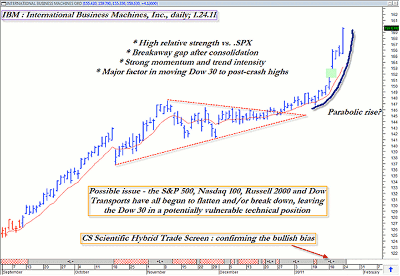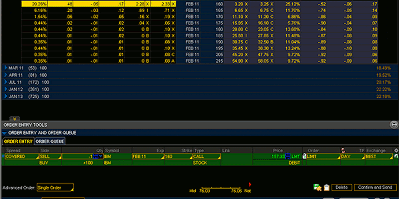Somehow, the Dow Jones Industrial Average (DJIA) manages to keep on chugging higher, even though many of its peer indexes are already beginning to fall by the wayside. International Business Machines (IBM) is the prime mover in the DJIA right now, and is still looking very strong. Figure 1 is a brief look at IBM's very interesting daily chart.
Without waxing too eloquently here, let's just say that this daily chart of IBM appears to be in tip-top technical health, and that under normal market conditions, it would also seem to make IBM a near-perfect candidate for a near-term covered call trade.
The stock made a powerful breakout from a nice consolidation pattern—and with a large breakaway gap to boot. As measured by one of the more powerful MetaStock expert advisors (the CS Scientific Hybrid Trade Screen; see the gray and red ribbons at the base of the chart), the stock also gets high marks for having strong momentum and trend intensity characteristics, too.
So what's not to like about going long shares of IBM at these lofty price levels? Generally speaking, not much, particularly from a short-term, covered call standpoint. In fact, you can buy a February IBM $160 covered call for about $157.33, and if the stock is called away at option expiration, you can expect to earn about a 20% annualized rate of return in less than four weeks.
This is an at-the-money (ATM) covered call (CC), so it won't provide as much protection against whipsaws as an in-the-money (ITM) CC set-up. As such, you'd need to act more quickly to close out a trade that was starting to move sharply against you.
Many times, a 21-period moving average and/or a significant uptrend line can serve as a reasonably effective stop-loss and/or trailing stop for CC trades, which generally benefit from a larger stop than a typical short-term swing trade. Regardless, at least we have a nice looking long CC set-up available in shares of IBM.
But is this really the best time to deploy such a strategy in the equities market?
Maybe. But then again, maybe not. See Figure 2 below.
While it's foolish to argue with such a potentially bullish trade set-up, a wise trader will also want to look at the big picture, including the current technical state of the major US stock indexes, and that's where the alarm bells start ringing.
With the Standard & Poor's 500, Nasdaq 100, Russell 2000, and Dow transport indexes all starting to flatten out and/or reverse lower, the technical imagery on our daily IBM chart suddenly doesn't look quite as safe, and, in fact, it could almost be viewed as gigantic red flag—one that says "Tread lightly" or "Fools rush in." Sooner or later, either the Dow 30's peer stock indexes start to perk up and join it on the road to higher post-crash highs, or the Dow 30 flares out, turns lower, and joins the other stock indexes on the path toward major support levels.
For real adventure seekers, perhaps putting on a covered call trade like this might make sense, but if you're the more conservative type, it's probably better to sit on the sidelines for a week or two until this divergence among the major US stock indexes begins to resolve itself.
While common sense dictates that the markets are more likely to correct soon rather than move quickly to even higher highs, the fact is that absolutely no one knows exactly what the market is going to do tomorrow, next week, or even next year. And this is one of those times when the old traders' wisdom of "When in doubt, stay out" really does seem to apply.
By Don Pendergast of ChartW59.com























